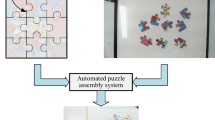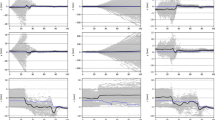Abstract
The problem of recognising overlapping parts is of considerable interest in industrial automation. While it is possible to employ carriers or pallets to separate or prearrange the parts for robotic assembly tasks, a vision system which can recognise the parts even though they may be partially overlapped and in random positions is much flexible.
In this paper, we employ a Hough transform technique to determine the poses (translations and rotations) of overlapping parts in the image. Shapes of parts are broken down into fragments, each representing either a line or a circular arc primitive. The geometrical relations and properties of primitives are used to derive the matching of primitive pairs between the model and the image. This paper also presents methods to determine the top-bottom relation of overlapping parts in grey-level image by tracing the shadowed points along the overlapping boundaries. The detected poses along with the top-bottom relation of overlapping parts provide sufficient information for robotic assembly in complex environment.
Similar content being viewed by others
References
T. Pavlidis and S. E. Horowitz, “Segmentation of plane curves”,IEEE Transactions on Computers 23, pp. 860–870, 1974.
L. P. Cordella, “An O(N) algorithm for polygonal approximation”,Pattern Recognition Letters 3, pp. 93–97, 1985.
B. Kr. Ray and K. S. Ray, “A new approach to polygonal approximation”,Pattern Recognition Letters 12, pp. 229–234, 1991.
K. Wall and P.-E. Danielsson, “A fast sequential method for polygonal approximation of digital curves”,Computer Vision, Graphics, and Image Processing 28, pp. 220–227, 1984.
M.-H. Han and D. Jang, “The use of maximum curvature points for the recognition of partially occluded objects”,Pattern Recognition 23, pp. 21–33, 1990.
M. W. Koch and R. L. Kashyap, “Using polygons to recognize and locate partially occluded objects”,IEEE Transactions on Pattern Analysis and Machine Intelligence 9, pp. 483–494, 1987.
E. H. Bouyakhf, “An approach for recognizing and locating overlapping industrial parts”,International Journal of Pattern Recognition and Artificial Intelligence 2, pp. 673–689, 1988.
N. Ayache and O. D. Faugeras, “HYPER: A new approach for the recognition and positioning of two-dimensional objects”,IEEE Transactions on Pattern Analysis and Machine Intelligence 8, pp. 44–54, 1986.
J. T. Schwartz and M. Sharir, “Identification of partially obscured object in two and three dimensions by matching noisy characteristic curves”,International Journal of Robotics Research 6, pp. 29–44, 1987.
S. Chaudhury, A. Acharyya and S. Subramanian, “Recognition of occluded objects with heuristic search”,Pattern Recognition 23, pp. 617–635, 1990.
W. E. L. Grimson and T. Lozano-Perez, “Localizing overlapping parts by searching the interpretation tree”,IEEE Transactions on Pattern Analysis and Machine Intelligence 9, pp. 469–482, 1987.
C. C. Lin and R. Chellappa, “Classification of partial 2-D shapes using Fourier descriptors”,IEEE Transactions on Pattern Analysis and Machine Intelligence 9, pp. 686–690, 1987.
C. T. Zahn and R. Z. Roskies, “Fourier descriptors for plane closed curves”,IEEE Transactions on Computers 21, pp. 269–281, 1972.
E. Person and K.-S. Fu, “Shape discrimination using Fourier descriptors”,IEEE Transactions on Systems, Man and Cybernetics 7, pp. 170–179, 1977.
O. R. Mitchell and T. A. Grogan, “Global and partial shape discrimination for computer vision”,Optical Engineering 23, pp. 484–491, 1974.
J. W. Gorman, O. R. Mitchell and F. P. Kuhl, “Partial shape recognition using dynamic programming”,IEEE Transactions on Pattern Analysis and Machine Intelligence 10, pp. 257–266, 1988.
W. A. Perkins, “A model based vision system for industrial parts”,IEEE Transactions on Computers 27, pp. 126–143, 1978.
J. L. Turney, T. N. Mudge and R. A. Volz, “Recognizing partially occluded parts”,IEEE Transactions on Pattern Analysis and Machine Intelligence 7, pp. 410–421, 1985.
E. R. Davies, “Occlusion analysis for object detection using the generalized Hough transform”,Signal Processing 16, pp. 267–277, 1989.
D. H. Ballard, “Generalizing the Hough transform to detect arbitrary shapes”,Pattern Recognition 13, pp. 111–122, 1981.
W. E. L. Grimson and D. P. Huttenlocher, “On the sensitivity of the Hough transform for object recognition”,IEEE Transactions on pattern Analysis and Machine Intelligence 12, pp. 255–274, 1990.
Y. Shirai,Three-dimensional Computer Vision. Springer-Verlag, Berlin, 1987.
R. Krishnapuram and D. Casasent, “Determination of three-dimensional object recognition and orientation from range images”,IEEE Transactions on Pattern Analysis and Machine Intelligence 11, pp. 1158–1167, 1989.
C.-H. Teh and R. T. Chin, “On the detection of dominant points on digital curves”,IEEE Transactions on Pattern Analysis and Machine Intelligence 11, pp. 859–872, 1989.
S. M. Thomas and Y. T. Chan, “A simple approach for the estimation of circular arc center and its radius”,Computer Vision, Graphics and Image Processing 45, pp. 362–370, 1989.
N. Otsu, “A threshold selection method from gray-level histograms”,IEEE Transactions on Systems, Man and Cybernetics 9, pp. 62–66, 1979.
Author information
Authors and Affiliations
Rights and permissions
About this article
Cite this article
Tsai, DM. Locating overlapping industrial parts for robotic assembly. Int J Adv Manuf Technol 12, 288–302 (1996). https://doi.org/10.1007/BF01239616
Issue Date:
DOI: https://doi.org/10.1007/BF01239616




